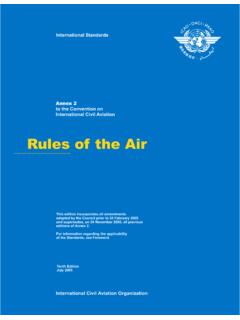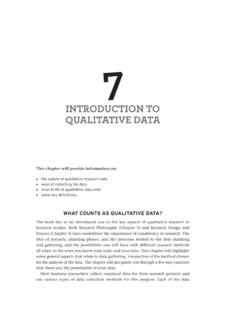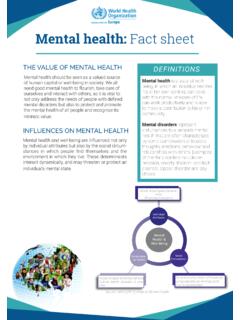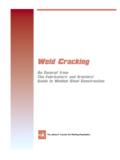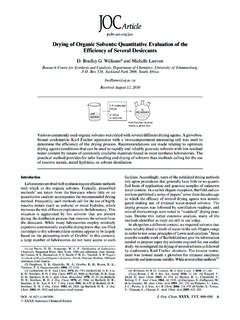Transcription of Deforestation in Canada. What are the facts?
1 The Canadian Forest Service of Natural Resources Canada mon -itors Deforestation to meet international climate change report -ing Deforestation rates are estimated using a combinationof satellite and aerial images, land-use records, and field inspec -tions. The results show that although there is some deforestationin Canada, most is driven by sectors of the economy other thanforestry, such as agriculture and urban development. What Is Deforestation ? Deforestation is the permanent removal of forest cover from anarea, and the conversion of this previously forested land to otheruses. In Canada, clearcutting or other harvesting practices areused as part of sustainable forest management to provide timberfor producing paper or wood products. This is not considereddeforestation because the area is replanted or allowed to regen-erate naturally, renewing the forest Much Deforestation Occurs in Canada?Canada s 402 million ha of forest and other wooded land accountfor about 10% of the world s forest cover.
2 In 2005, an estimated56 000 ha were deforested in Canada. Over the past 30 years,except for large hydroelectric projects in the late 1970s andearly 1980s, annual Deforestation rates have been , Deforestation affected less than of Canada s forestsin 2005. A portion of this Deforestation is offset by increasesin forest area due to afforestation (planting of new areas of forest),estimated at 9400 ha in , about 13 million ha of forest are deforested eachyear the area of Nova Scotia and New Brunswick Deforestation in Canada represents only approxi-mately of global Deforestation , far less than Canada s10% share of the world s forests. Around the world, deforestationis a major issue because it reduces biodiversity, affects waterand soil quality, and is an important contributor to climatechange. Although the rate of Deforestation in Canada is quitelow, it still makes sense to try and reduce it where possible.
3 What Activities Cause Deforestation ?The agriculture sector accounted for just over half of the defor-estation in 2005 (see chart), the result of forests having beencleared for pasture or crops. The remainder was caused by urbandevelopment, transportation corridors, and recreation (19%);hydroelectric development (10%); the forest sector (10%); andother natural resource extraction industries (8%). About two-thirds of this Deforestation occurred in Canada s boreal forest,CANADIAN FOREST SERVICE SCIENCE-POLICY NOTESMay 2008 Deforestation in Canada What Are the facts? Area deforested for recreational usage (golf course) in SouthernOntario. (Don Leckie, Natural Resources Canada) Deforestation in Canada A Snapshot Deforestation is not logging it is the result of clearing treesfor a change to a non-forest land use, such as agriculture. Deforestation affected less than of Canada s forestsin 2005. Canada s Deforestation rate accounts for only ofglobal Deforestation .
4 Solutions are complex, requiring the involvement of manyplayers. Integrated landscape management and otherbest practices are part of the answer, as is raising publicawareness about the issue. mainly in areas in Alberta, Saskatchewan, and Manitoba wherethe forest borders the Can We Reduce Deforestation in Canada? Deforestation in Canada is driven by demand for resource devel -opment, economic growth, and the need to build to reduce Deforestation must therefore be balancedagainst other goals, such as expanding the economy, diversifyingeconomic activities, and supporting community employment. As a result, finding solutions to reduce Deforestation is chal-lenging. There is a range of government policies and regulationsthat affect development, and these vary by sector and jurisdic-tion. Policies and regulations generally deal with other environ -mental, safety, or economic issues not Deforestation .
5 A furtherchallenge is the lack of public awareness about and the public have only recently begun to focuson this issue. Because of increasing awareness, governments and industry aretrying to better understand and reduce Deforestation in that we need a more comprehensive approach,provincial governments are increasingly using innovative prac-tices such as integrated landscape management (ILM).Integrated landscape management means planning land usesover an entire landscape and encouraging different land usersto work together. For instance, ILM has been used in Albertato coordinate forest clearing with oil sands development, to ensureforest companies harvest timber from sites to be cleared for oiland gas, and to prevent forest clearing for oil and gas develop-ment in newly replanted areas. British Columbia has also usedILM to encourage the various industries operating in forests toshare roads rather than each building its own.
6 ReferencesEnvironment Canada. 2007. National Inventory Report, 1990 Gas Sources and Sinks in Canada. [Accessed January2008.]Global Forest Resources Assessment. 2005. Food and Agriculture Organ -ization of the United Nations. Rome. [Accessed January 2008.][IPCC] Intergovernmental Panel on Climate Change. 2007. ClimateChange 2007: The Physical Science Basis. Contribution of WorkingGroup I to the Fourth Assessment Report of the IPCC. S. Solomon,M. Manning, Z. Chen, M. Marquis, K. B. Averyt, M. Tignor, Miller (eds.). Cambridge University Press, UK. [Accessed January 2008.]For more informationE-mail: Her Majesty the Queen in Right of Canada, 2008 ISBN 978-0-662-47858-4 Cat. no. Fo93-1/3-2008E-PDFArea deforested for agricultural purposes near Quyon, Quebec.(Roberta Gal, Natural Resources Canada)Urban development, transportation, and recreationIndustry and resource extractionHydroelectricityForest roadsAgriculture53%19%8%10%10%53%19%8%10 %10%Causes of Deforestation in Canada for and Greenhouse Gas Emissions The Canadian Forest Service estimates greenhouse gasemissions from Deforestation for inclusion in EnvironmentCanada s greenhouse gas National Inventory estimates show that, in 2005, Deforestation causedless than 3% of the total greenhouse gas emissions inCanada.
7 In comparison, Deforestation worldwide results inup to 20% of global human-caused emissions according tothe Intergovernmental Panel on Climate Change most ofthis is in developing countries. Since Canada s total green-house gas emissions are about 2% of global emis-sions, Deforestation in Canada represents a very smallproportion of global greenhouse gas emissions.

